feature
Exit Tickets
Understanding students, adapting instruction, and addressing equity
The Science Teacher—April/May 2019 (Volume 86, Issue 8)
By Kelsie Fowler, Mark Windschitl, and Jennifer Richards

The ideas students bring to class and their perspectives on what is happening in the classroom change constantly. Keeping track of these changes is useful for adapting lessons, nurturing student self-reflection, increasing student ownership of learning, and building a teaching practice responsive to learners’ needs. In this article, we discuss how a simple formative assessment tool—exit tickets—can be used to help teachers do this work.
Exit tickets are short response tasks that teachers administer to students after an activity (such as laboratory experiment) or class period. They present opportunities for teachers to elicit students’ thinking without affecting their grade, provide individualized feedback, and identify learning needs or modifications to an instructional plan (Black and Wiliam 1998).
Exit tickets can be used to ask students about their understanding of a science idea (e.g., respiration or sound energy), everyday experiences that relate to the current unit, or comfort level with a given skill (e.g., use of calorimeters or data analysis). They can also be used to record the strategies students used to prepare for an assignment, small group dynamics, or whether students felt their ideas were valued in class.
To be effective, an exit ticket should have specific prompts for students and take only about five minutes to complete. Students can record their responses on index cards, sticky notes, notebook paper, or online (e.g., Google Forms, Padlet, Schoology, etc.). Ideally, student responses inform the next stages of learning by highlighting whether teachers should clarify ideas, reteach them, extend them, offer practice, introduce new ideas, or restructure future instructional activities (Marshall 2018).
Additionally, studies suggest that formative assessments can be used to do more than evaluate student content understanding—they can help develop and maintain equitable teaching routines. The Center for Educational Research and Innovation (CERI 2005) highlights how “teachers using formative assessment approaches and techniques are better prepared to meet diverse students’ needs—through differentiation and adaptation of teaching [to] achieve a greater equity of student outcomes.” Gloria Ladson-Billings (1995) examines the concept of using formative assessments to increase equity in classrooms, arguing that among other factors, equity depends on teachers maintaining fluid teacher-student relationships and demonstrating connectedness with all students.
Exit tickets are unique in that they routinize access to students’ thinking and reflections while providing a private, protected platform for students who do not typically contribute publicly to share their perspectives. In doing so, exit tickets can support conditions where all students have a voice in the classroom, know they are heard, and can share ownership of the learning. This feedback loop is shown in Figure 1. Next we discuss different types of exit tickets (including those that can be used as tools to assess equity) and share practical strategies for using them in the secondary science classroom.
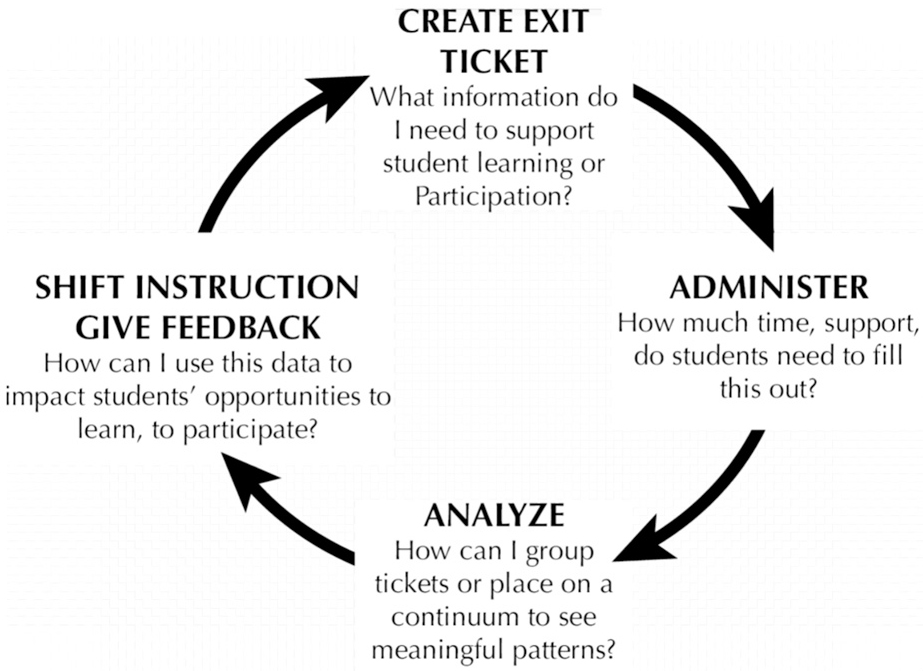
Exit ticket feedback loop
Our “mini-experiment”
We organized a group of middle and high school science teachers from varying science disciplines to explore the use of exit tickets across 13 classrooms so that we could work toward best practices for designing, analyzing, and then acting on these assessments. Each teacher selected from several types of exit tickets (see Table 1), designed specific prompts, and then proctored, collected, and analyzed one set from a middle school or high school class. We share several specific examples of exit tickets later in the article.
| Table 1. Types of exit tickets and associated next steps. | ||||||||||||||||||||
|---|---|---|---|---|---|---|---|---|---|---|---|---|---|---|---|---|---|---|---|---|
|
||||||||||||||||||||
The only caveat was that we asked teachers to store the exit tickets in an envelope and wait until we were all together to review them. On the day of the review, teachers were given seven minutes to look through their exit tickets, make sense of the results with a partner, and consider next steps. While this time frame may seem too short, what good is an exit ticket if results cannot be quickly interpreted after school or during a single planning period?
What we learned
Teachers began their reviews by predicting what they expected to uncover and why. Predicting student responses before looking at the tickets can be a useful reflective practice, but we also stressed that participants should remain open to unexpected results. After opening the envelopes, teachers quickly sorted the exit tickets (Figure 2) into piles representing:
- most-common to least-common responses
- topics or components of a science idea that students write about
- apparent depth of understanding
- types of hypotheses about an event or process
- ideas students are puzzled about
- degree of self-perceived participation (in a group, whole class)
- degree to which students say their ideas are “listened to” by others
- ideas students have about lab skills or science and engineering practices
- helpful or unhelpful teacher practices
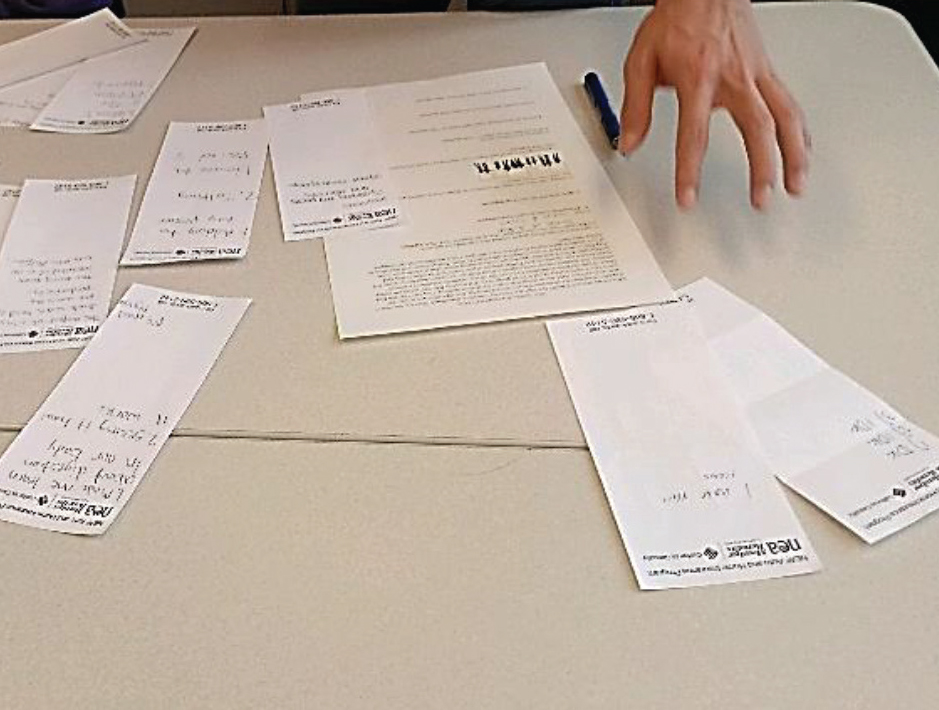
Sorting exit tickets
During the sorting process, teachers could be heard around the room discussing common themes in the exit tickets. While some reviewed the pile sizes to estimate trends, a few tallied individual responses for more precise analysis. We picked up comments like “I think my questions were not clear enough to get at what my students know” “I don’t think most of them understand ________” or “I need to pay careful attention to [this group of students] because ____.” One teacher noted: “Wow this is really good to know. About half of my students want more instruction on ions.” Another teacher was pleased to realize that “lots of my students were super honest—I thought more would fudge about how much they prepared for the quiz, but I really don’t think they did.”
One participant, unable to quantify student answers, shared two exit tickets that illustrated a proper but unhelpful answer; it was unclear whether the student was hiding behind scientific vocabulary or truly understanding the concept. Recognizing that this resulted from the phrasing in her prompts, she decided to reword one question from “What is Standard Temperature and Pressure (STP)?” to “Why is STP necessary for understanding our phenomenon?” She reworded another from “List two reasons why volume is variable,” to “What are two reasons the balloon expands and two reasons the balloon contracts?”
With the sorting stage complete, teachers examined the sorted piles and answered a set of questions:
- What patterns do I see?
- How would I change the formatting of the exit ticket or what I ask for?
- What am I going to do about what I see? How will I respond to this information in a way that is visible and empowering to students?
Responses to these questions varied greatly; a few teachers promised to start class the next day with a class discussion about how the classroom environment could be more supportive for learning. Another teacher expressed her plan to speak with a few individuals about the growth of their ideas. Still others planned on grouping students by their familiarity with content ideas, improving specific types of activities to better meet the needs of students, and more thoughtfully reviewing concepts using the gaps identified in the exit ticket responses.
Figures 3–6 show different types of exit tickets and how teachers made use of them. For each, we provide teachers’ reflections, evaluate the strength of the exit ticket itself, and offer suggestions.
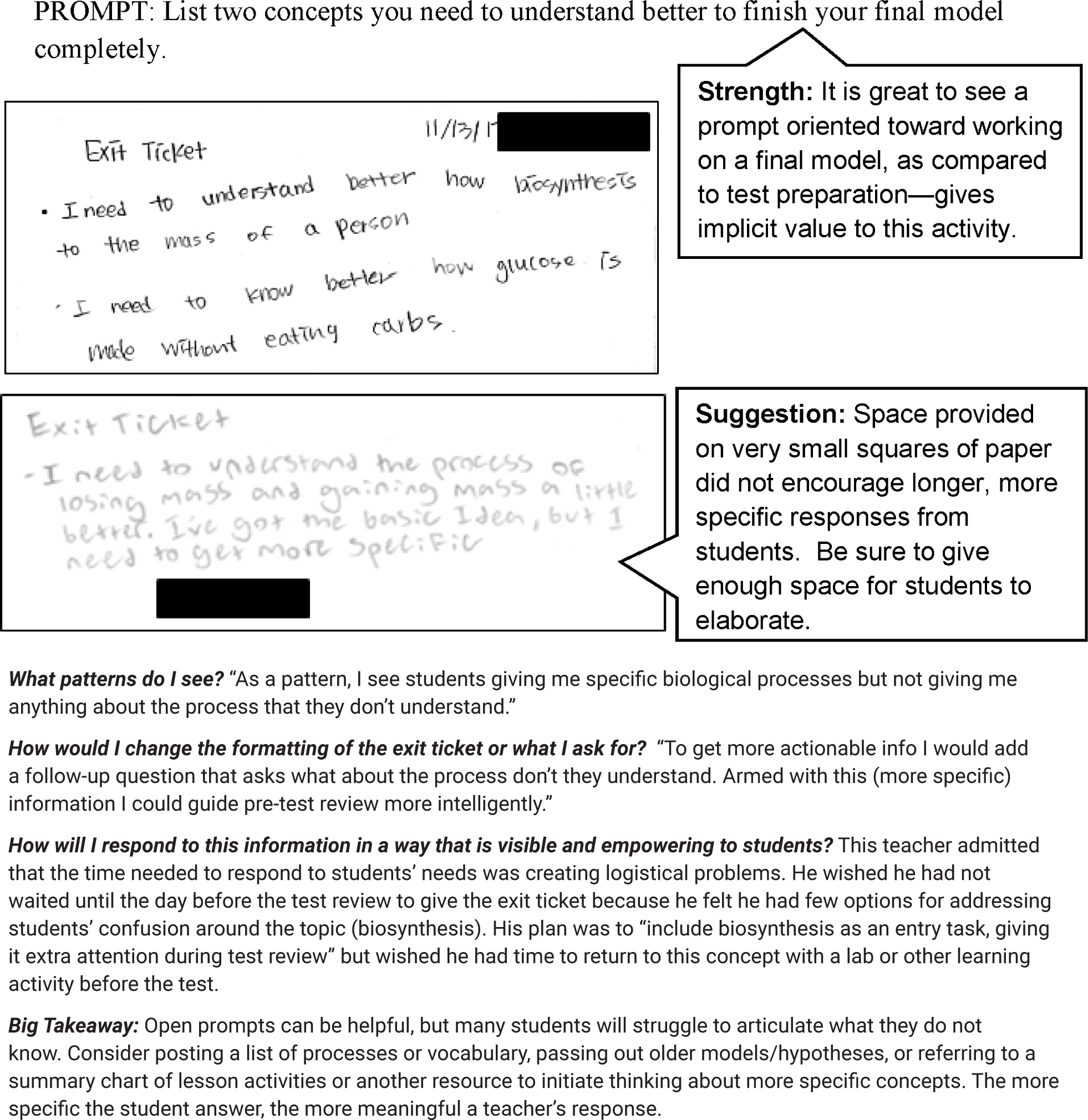
Exit ticket for content check
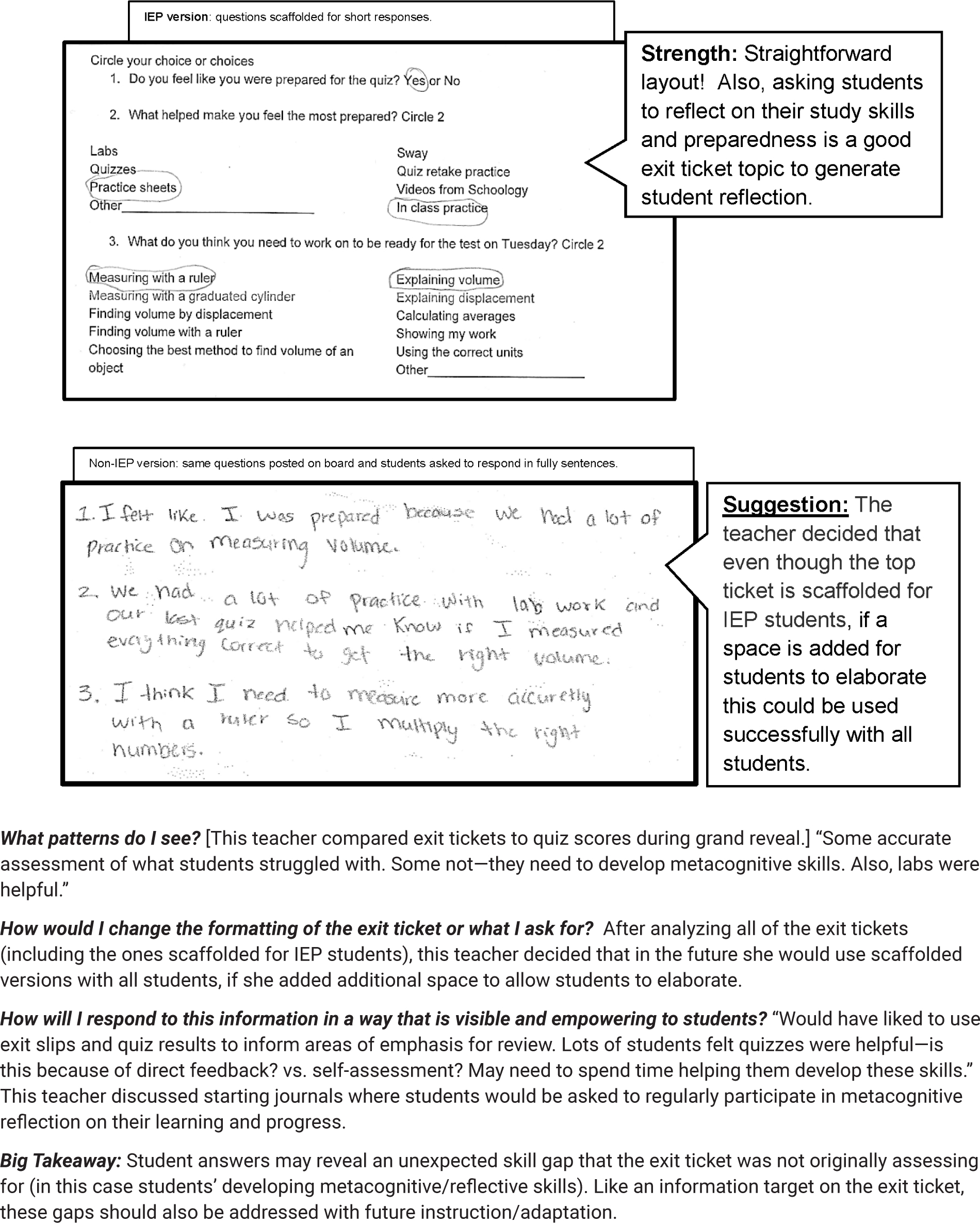
Two versions of exit ticket on preparedness
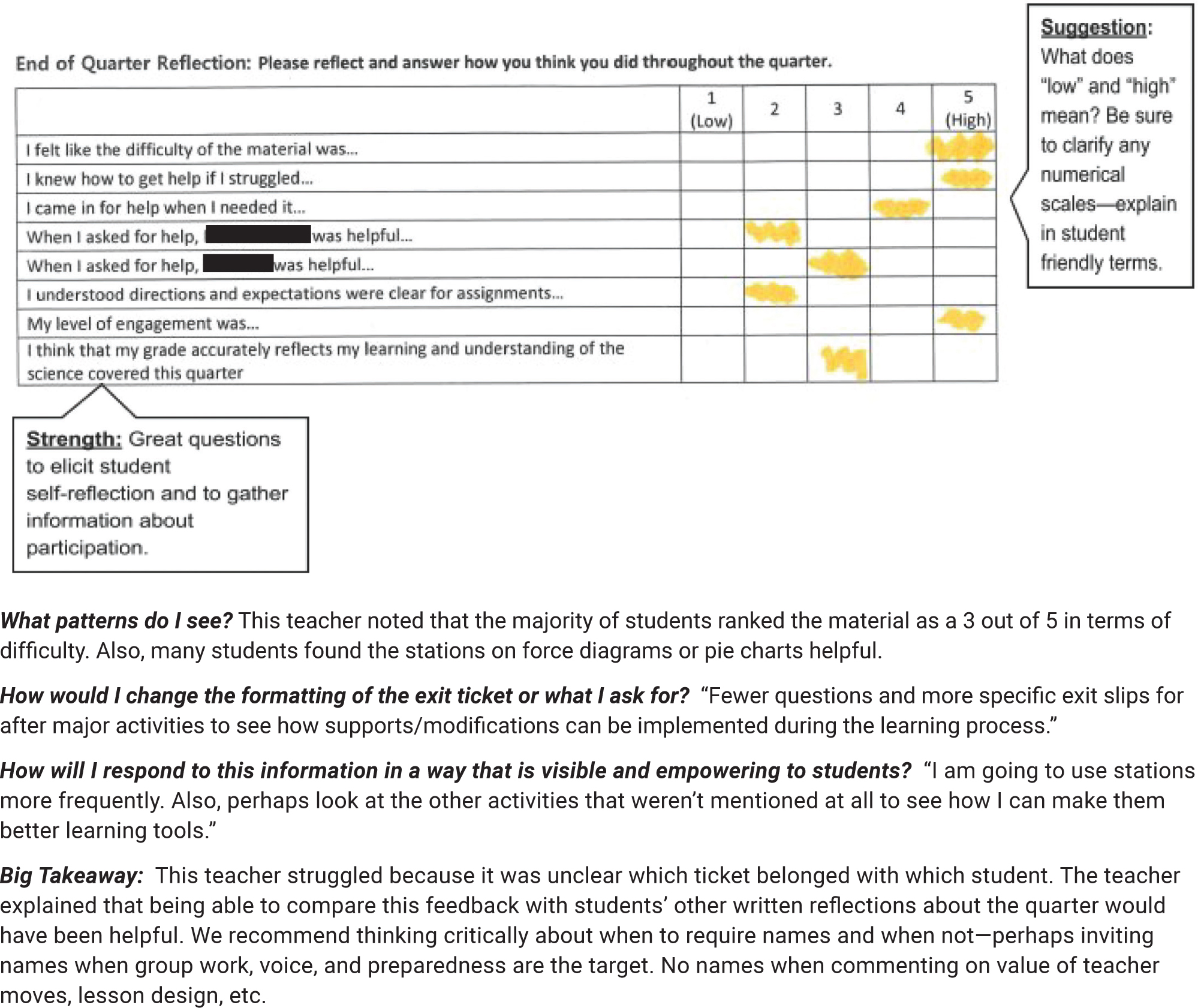
Exit ticket on reflections on participation and study habits
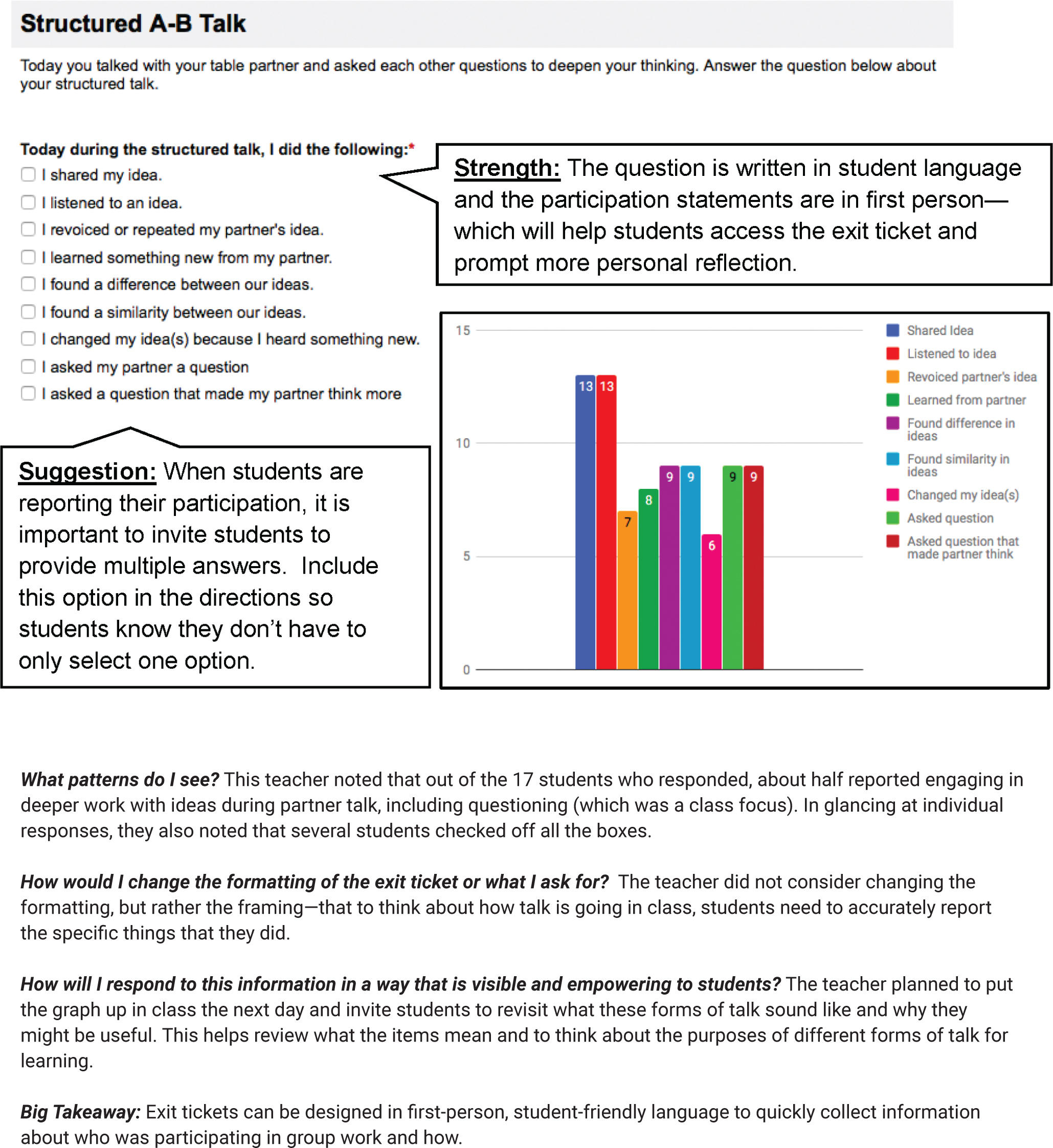
Exit ticket for participation in partner talk
Summary
After making sense of students’ responses and determining next steps, teachers worked together to generalize criteria for designing and administering quality exit tickets. These included:
- Frame the reasons you are asking students to provide information. If students understand how the information will be used, they are more likely to provide relevant, accurate responses.
- Keep the length short (no more than one to two questions if students are asked to do more than select answers).
- Write simple directions, worded with precision (no room for ambiguous language).
- Connect with the day’s learning experiences—don’t reach back in time with your prompts.
- Design prompts to elicit more than one-word responses.
- Vary the format depending on population of class (English language learners, age, students with IEPs or 504s, etc.).
- Do not limit yourself to administering exit tickets at the very end of class—they can be productive in the middle or even at the beginning and end to see evolution of student thinking and measure a lesson’s success.
- Consider using online exit tickets if computer use is a routine part of classroom procedures. Doing so alleviates the need for hard copies and can reduce sorting time because many digital programs can generate summary reports. (A few free user-friendly digital tools that automatically generate reports include: Google Forms, Socrative, PollEverywhere, or even Twitter.)
Options for structuring and using exit ticket feedback to inform classroom practices and interactions with students are endless. The power of exit tickets lies not only in informing instructional decisions—it includes the public acknowledgment of students’ ideas and making adaptations of lessons, based on these responses, transparent to students (Marshall 2018). Importantly, exit tickets can also give voice to students who are otherwise silent in class, including English language learners and students “on the margins” of classroom life, and can draw your attention to who is being served in which ways, giving you critical information for shaping your practice to enhance equity and inclusivity.
Assessment Equity Life Science Middle School High School


